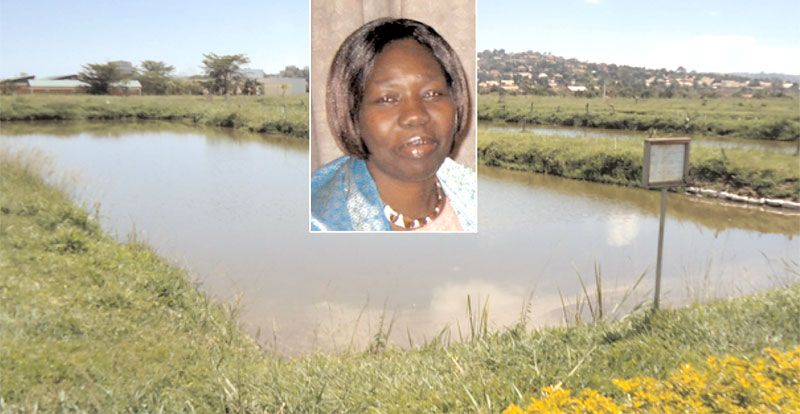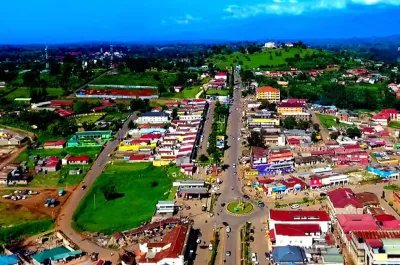

A fish pond at Kajjansi Research Development Centre (Inset) is Joyce Ikwaput Nyeko, Commissioner at the Ministry of Agriculture
Fish is the most sought after source of protein in Uganda and arguably the whole world, judging by the value it commands both locally and internationally.
On the local market, the demand for fish has sky-rocketed in recent years and pushed the price to the highs of between 10,000/= and 20,000/= a kilo, depending on the type of fish. Nile Perch, versatile predator is the most sought after fish by exporters as well as fish lovers in Uganda.
Across the country, the Nile Perch currently sells like a hot cake. The increase in the country’s population, coupled with increased trade with neighbouring countries such as South Sudan, D.R Congo, is some of the reasons behind the runaway demand for fish.
But the more the price has risen, the more people have ventured into the lakes and rivers to hunt for the delicacy in a hot pursuit to take advantage of the handsome price. This has produced a raft of adverse effects, the most immediate one being the depletion of fish from the country’s water bodies.
Although fish stocks have dwindled considerably, Uganda’s vast fresh water lakes and rivers, continue to provide favourable conditions for fish production. With up to 18 percent of Uganda’s total land area, the potential for fish production is enormous.
It is perhaps out of this realization that the government developed a policy on aquaculture of fish farming, with the view to promoting fish farming as an economic activity that can generate foreign exchange while creating jobs and incomes for millions of Ugandans.
In an exclusive interview with Joyce Ikwaput Nyeko, a Commissioner in the Department of Aquaculture Management and Development in the Ministry of Agriculture, she revealed that fish farming has grown exponentially over the last decade.
According to Ikwaput, there are over 14,000 fish farmers registered with the ministry at the moment.
Majority of the farmers, according to Ikwaput, prefer to raise fish in ponds because they are easy to manage, compared with cages, which require security and a considerable amount of capital to start.
She said: “The ministry has now registered over 27, 000 fish ponds and 3,000 fish cage farms and this has helped us to increase Aquaculture production and value from 5.4% to 8% as of 2016 statistics.”
Current estimates show that annual fish production from farms is about 90,000 tones, accounting for about 10% of total fish production.
The increase in the number of fish farmers has helped to recover the industry that was facing enormous pressure from exporters. Besides over-fishing by both locals as well as foreigners, Ikwaput also blames the increase in the levels of pollution, use of illegal fishing gear, and dangerous water weeds are causes of fish depletion.
Ikwaput revealed to our reporter that majority of farmers have ventured into farming Nile Perch, Cat Fish and Tilapia as the most common types of fish. A few of them had ventured into raising Mukene or silver fish, but were discouraged by the relatively lower price of about 5000/= it fetched, compared to say Nile perch despite the fact that they both need about the same period (nine) months to reach maturity.
The industry, according to Ikwaput, has been characterized with successes and failures.
The biggest challenge to fish farming in Uganda, according to Ikwaput, is the high cost of fish feeds. Fish, like chickens need proteins and carbohydrates to grow.
And like other forms of intensive farming, fish farming in Uganda relies on a nascent fish feed manufacturing industry. The fish feed industry is dominated by a few players such as Ugachick.
Further more, the industry suffers from competition for inputs with the poultry sector as well as humans for feed. The demand for Silver fish and Soy beans, emerge as two commodities whose demand has risen sharply in recent years. Still, even with the emergence of feed producing factories, a number of farmers have reported challenges of poor quality feeds from major producers, which causes delays in maturity.
Seasonal factors such as droughts have further rendered the supply of fish feed irregular and adversely affected planning and marketing.
The challenge of diseases and predators such as snakes, diving birds and humans have proved yet again a source of headache for farmers and brought about added costs in terms of disease management and security.
Despite the challenges, Ikwaput argues that government is considering fish farming as one sector with the greatest potential and has thus invested in it.
The redevelopment of the Aquaculture Research Development Centre at Kajjansi along Entebbe road, with financial assistance from the Chinese government and the government of Uganda, is seen as one of the efforts through which the government is encouraging the promotion of fish farming in Uganda.
According to Godfrey Kityo, the Farm Manager at the Kajjansi facility, the centre’s core role is to provide aquaculture engineering and production services. This involves guiding people on how to build, maintain and handle their cultural fish farms. It also has a role of providing information about the potential of fish species for aquaculture.
Kajjansi Aquaculture Research Development Centre also acts as a Genetic Quality Improvement centre, a role it performs by ensuring that it improves on the fish breed characteristics, while also helping to preserve the genetic characteristics of Ugandan fish.
Ikwaput noted that the government through Operation Wealth Creation (OWC) is supporting selected individuals to access quality seed or fingerings.
The experience of Esther Namyalo, a fish farmer at Kitubulu along Entebbe road, offers hope to those who wish to venture into this industry. Namyalo says she ventured into the industry three years ago, after enduring devastating losses in her poultry business. Although she admits the entry point was made steep by the need for higher levels of capital, the rewards are much better than those of poultry.
She told this reporter that she initially faced challenges of diseases and pests, until she went to Kajjansi aquaculture centre where she obtained new skills that have proved handy up to date.
“I previously used to keep chicken, but one day, my entire flock was wiped out by disease. yet I had acquired that money from the bank.”
The challenge of disease, according to Kityo can be overcome by ensuring proper hygiene for the ponds and ensuring that the water PH is favourable for a specific type of fish.
Namyalo also complains that the high cost of feed remains one of the greatest challenges to the industry.














Sunrise reporter
Leave a Comment
Your email address will not be published.